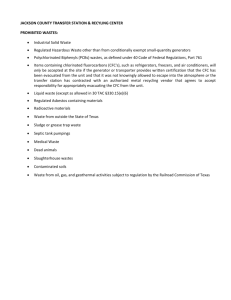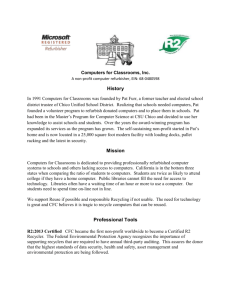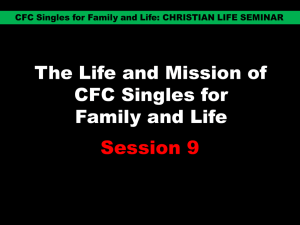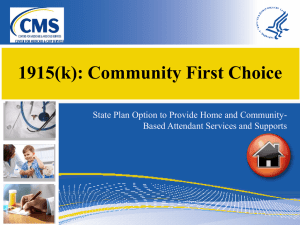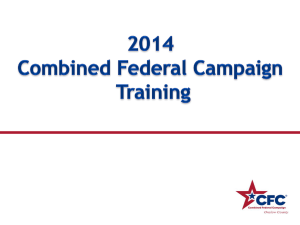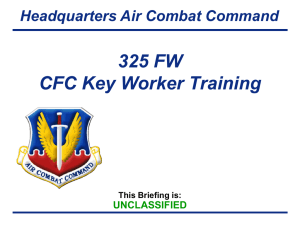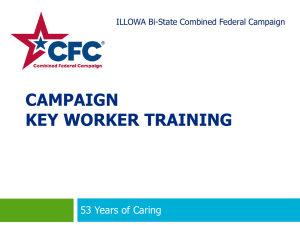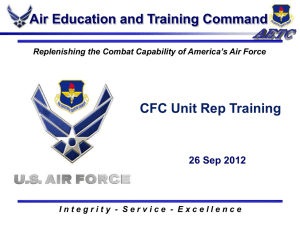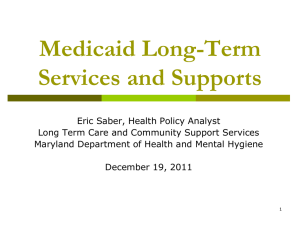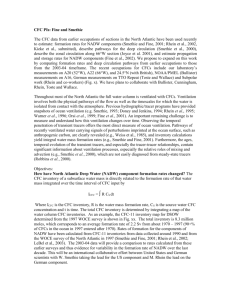Implementing the Community First Choice Option in New York
advertisement
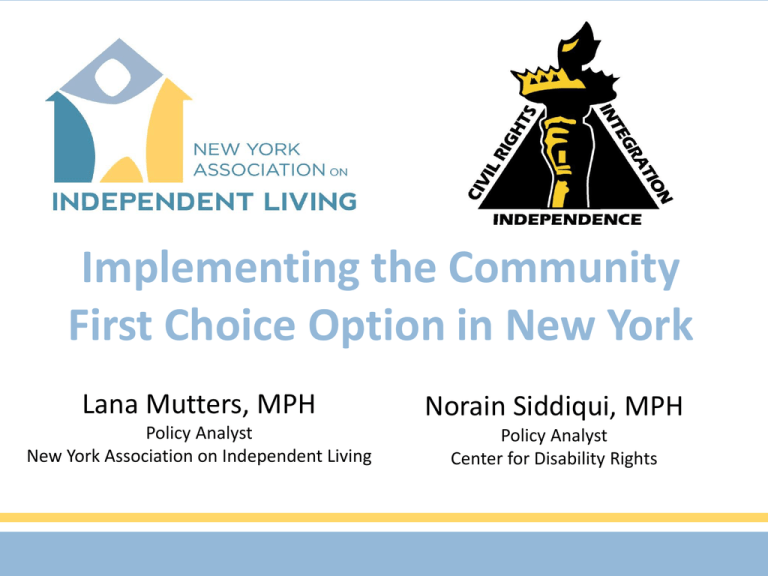
Implementing the Community First Choice Option in New York Lana Mutters, MPH Norain Siddiqui, MPH Policy Analyst New York Association on Independent Living Policy Analyst Center for Disability Rights History • Grassroots – ADAPT • Community Choice Act (CCA) • Affordable Care Act includes Community First Choice Option (March 2010) • New York State – Selection of Option (March 2011) • DOH CFC Workgroup (June 2012) What is CFC? Community-based Medicaid state plan service (1915[k] State Plan Amendment) Includes hands-on assistance, safety monitoring, cueing, ADL, IADL First program to provide services based on functional need, not diagnosis or age Eligibility • Must be Medicaid eligible • Must require an institutional level of care (hospital, nursing facility, ICF-MR, or IMD) Background and Basics Affordable Care Act establishes Community First Choice (CFC) under § 1915(k) of Social Security Act under Medicaid CFC supports independence, integration, personcentered, consumer-directed in accordance with the Olmstead decision of 1999 As state plan amendment, entitlement Services must be provided in community-based setting CANNOT include: • Nursing facilities • Institutions for Mental Diseases (IMD) • Intermediate Care Facilities for Mentally Retarded (ICF-MR) • Any public/private facility that provides inpatient institutional treatment • Any building on grounds of disability-specific housing complex Required Services • Attendant services and supports for – activities of daily living (ADL) – instrumental activities of daily living (IADL) – health-related tasks • Attendant services and supports include – hands-on assistance – safety monitoring – cueing • Assistance with the learning skills necessary to accomplish ADL, IADL, and health-related tasks • Purchase of back-up systems (beepers) to ensure continuity of services and supports • NYS must develop/offer a voluntary training on how to select, manage, dismiss attendants Permissible Services & Supports • Transition costs – i.e. security deposits for rent/utilities – purchasing basic kitchen supplies, etc. • Services that increase independence or substitute for human assistance – i.e. learning how to use public transportation Excluded Services • Room and board • Special education and related services provided under IDEA and vocational rehab • Assistive technologies (other than those used as back-up systems) • Medical supplies and equipment • Home modifications Models for Service Delivery • “Agency Provider Model” * – – – – • range of approaches individual has ability to select, train, dismiss attendant Traditional agency managed services Agency-with-Choice model where the agency operates solely as a fiscal intermediary “Self-Directed Model with service budget” – Vouchers – Direct Cash Payments (similar to Cash & Counseling) – Fiscal Agent * Chosen by New York in State Plan Amendment How does CFC benefit New York? • Supports Governor’s commitment to Olmstead • Enhanced 6% FMAP with no sunset • Addresses gaps in long term care system • Streamlines system to reduce administrative redundancies How is CFC different? • Cross-disability • Home and/or community settings • Includes transition costs from an institution to a home • Maximizes consumer control and allows for a proxy chosen by individual to direct care • Supplemented with backup and emergency attendant services • Voluntary training on how to self direct • Availability of equipment or e-mods that substitute for human assistance CFC will work for you • Applicable in multiple settings • Flexible scheduling • Person-centered • Eliminates silos • Self-direction • Budgeting New York’s State Plan Amendment • Submitted in December 2013, still awaiting CMS approval • “Agency with Choice” model • NYAIL & CDR would like to see clarifications on: 1. IADL “Care of others” 2. Stakeholder feedback Notable Issues • Definition of “community” and “setting” – Dept. of Health and Human Services finalized definition in January 2014 – Rules now in line with Olmstead …settings do not include a nursing facility, institution for mental diseases, or an intermediate care facility for individuals with intellectual disabilities…we have established that home and communitybased settings must exhibit specific qualities to be eligible sites for delivery of home and community-based services. Notable issues cont. • Nurse Practice Act – NPA only allows licensed nurses to perform health-related tasks (i.e. catheter, vent care, etc.) – Must be amended to allow “advanced aide” to do these tasks, as overseen by nurse • Cost effective • Aides already perform tasks in CDPAP • Nurse shortage – Contentious debate between NYS, NYSNA, disability rights groups over patient safety, professional scope, civil rights Nurse Practice Act cont. • If State fails to enact NPA exemption, entire SPA could be dismissed by CMS • CFC requires services to be delivered “without regard to the individual’s age, type or nature of disability, severity of disability, or the form of home and community-based attendant services and supports that the individual requires to lead an independent life.” Where are we now? • • • • Waiting for CMS to approve SPA CFC in the budget process Presented draft CFC language to Assembly Pending CFC legislation CFC in other states Currently Participating • California • Oregon • Maryland State Plan Amendment Withdrawn • Arizona • Louisiana Plan to Participate 2014 Fiscal Year • Montana • Texas • Arkansas • Wisconsin • Minnesota Additional resources DOH CFC workgroup http://www.health.ny.gov/facilities/long_term_care/ Final regulations https://www.federalregister.gov/articles/2012/05/07/2012-10294/medicaid-programcommunity-first-choice-option CMS final rules on HCBS http://www.medicaid.gov/Medicaid-CHIP-Program-Information/By-Topics/Long-TermServices-and-Supports/Home-and-Community-Based-Services/Home-and-CommunityBased-Services.html Questions? Lana Mutters New York Association on Independent Living (518) 465-4650 LMutters@ilny.org Norain Siddiqui Center For Disability Rights (518) 320-7100 nsiddiqui@cdrnys.org
